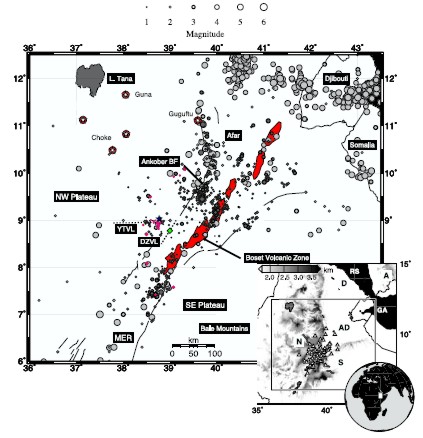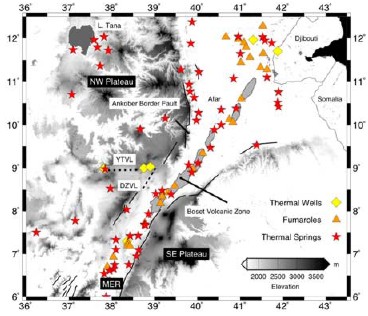
Figure 1: Distribution of earthquakes in Ethiopia. Light grey circles are earthquakes during 1960–2008 [Ayele and Kulha´nek, 1997] (NEIC). Dark grey circles are earthquakes during October 2001 to January 2003. Red filled segments show the volcanically active rift axis of the MER. Inset shows topography of the region. Tectonic plates are labelled as follows: A, Arabian; D, Danakil; N, Nubian; S, Somalian. Major rift zones are labelled as follows: RS, Red Sea; GA, Gulf of Aden; AD, Afar Depression.
Lower crustal earthquakes near the Ethiopian rift induced by magmatic processes by D. Keir et al, 2009a
Non-technical summary
Most earthquakes occur at shallow depths in the Earth’s crust. However, earthquakes in the lower crust are sometimes observed under continental rifts at depths at which the temperatures should be too high for them to occur. This study looks at earthquakes beneath the Main Ethiopian Rift and the northwest Ethiopian Plateau (figure 1) and uses information on the properties and structure of the crust and upper mantle to help explain the occurrence of anomalously deep earthquakes.
Earthquake and volcanic activity are predominantly within the Main Ethiopian Rift, however, active chains of volcanoes, scattered earthquakes and hydrothermal activity (eg. thermal springs, wells and fumeroles – figure 2) are also present along the rift margins and beneath the northwest Ethiopian Plateau.

Figure 2: Distribution of known thermal springs (red stars), thermal wells (yellow diamonds), and fumaroles (orange triangles) plotted on the topography of Ethiopia. Geothermal features are prevalent along the axis of the MER and on the NW plateau but are completely absent on the SE plateau. Data provided by G. Demissie of GeoMET Plc.
Earthquakes within the rift generally occur at less than 15km deep, whilst those near the western rift margins and beneath the Plateau occur down to 35km. These deep earthquakes are concentrated near recent volcanoes and where geophysical data indicate the presence of partially melted rocks within the lower crust. These partial melts likely form by melting of upper mantle rocks (at about 50-90km depth) due to the decrease in pressure as they gradually rise towards the surface as the plates stretch.
The data suggest that lower crustal earthquakes are caused by rapid rock fracturing close to where these partial melts are emplaced into the lower crust.
Full paper (PDF file)
